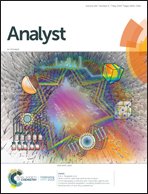An ultrasensitive and simple fluorescence biosensor for detection of the Kras wild type by using the three-way DNA junction-driven catalyzed hairpin assembly strategy†
Abstract
In this work, a label-free fluorescence biosensor was proposed for simple detection of the Kras wild type by using the three way DNA junction-driven catalyzed hairpin assembly strategy. In this system, a three-way DNA junction probe (JP) and two hairpin probes (H1 and H2) were designed. In the presence of the Kras wild type, an autocatalytic DNA machine can be activated. This leads to the generation of numerous free G-rich sequences, which can associate with a fluorescent dye N-methylmesoporphyrin IX (NMM) to yield an amplified fluorescence signal for the target detection. This sensing platform showed a high sensitivity towards the Kras wild type with a detection limit as low as 2.7 fM without any labelling, immobilization, or washing steps. The designed sensing system also exhibits an excellent selectivity for the Kras wild type compared with other interference DNA sequences. Furthermore, the presented biosensor is robust and has been successfully applied for the detection of the Kras wild type in a real biological sample with satisfactory results, suggesting that this method is promising for simple and early clinical diagnosis of genetic diseases. Thanks to its simplicity, cost-effectiveness, and ultrasensitivity, our proposed sensing strategy provides a universal platform for the detection of other genetic diseases by substituting the target-recognition element.



 Please wait while we load your content...
Please wait while we load your content...